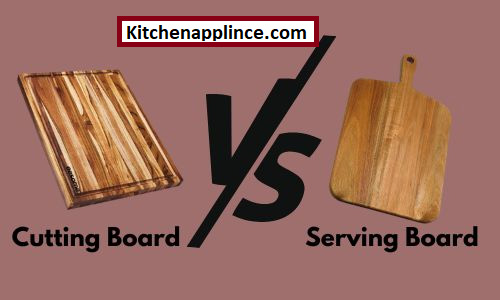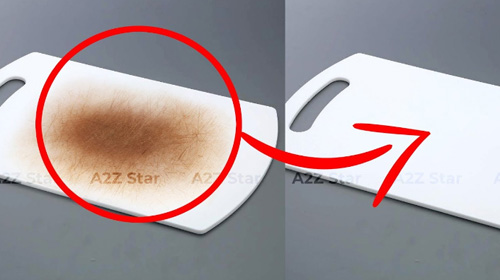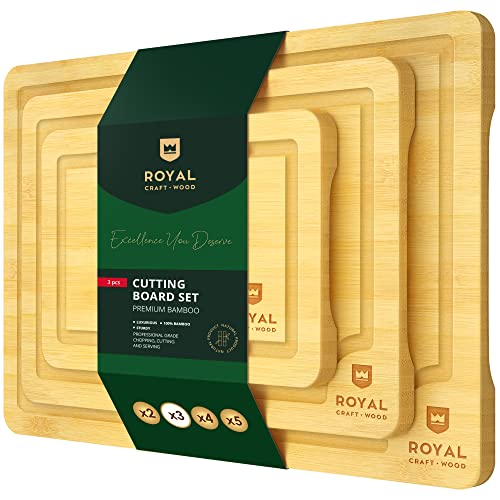Difference Between Cutting Board vs Serving Board

When it comes to boards, customers often wonder what the difference is between cutting and serving boards. It’s a great question! Let’s take a closer look at the differences between these two types of boards.
There are a few important differences between a cutting board vs serving board. A cutting board is designed for food preparation and is typically larger and more sturdy than a serving board. It’s often used to chop meat, fruits, and vegetables. On the other hand, a serving board is designed for eating and is thinner and less durable. It’s typically used to serve appetizers, desserts, or side dishes.
Difference Between Cutting Board vs Serving Board?
Cutting boards and serving boards serve distinct purposes in the kitchen, each designed with specific features to accommodate their intended functions. Here’s a breakdown of the key differences between cutting boards and serving boards:
Cutting Board:
- Function: A cutting board is primarily used for chopping, slicing, and preparing ingredients. It provides a stable and safe surface for cutting with knives.
- Material: Cutting boards can be made from various materials, including wood, plastic, bamboo, silicone, and rubber. The choice of material can impact the durability, knife-friendliness, and maintenance of the board.
- Surface: The surface of a cutting board is designed to be knife-friendly, which means it’s not excessively hard or abrasive to prevent dulling the knife blades.
- Size and Thickness: Cutting boards come in different sizes and thicknesses. Thicker boards are generally more durable and less prone to warping, while thinner boards can be more lightweight and easier to store.
- Maintenance: Proper cleaning and maintenance are essential to prevent bacterial growth and cross-contamination. Cutting boards should be cleaned after each use and periodically treated with food-safe mineral oil (for wood boards) to keep them in good condition.
- Design: Cutting boards are designed with functionality in mind, often featuring a simple rectangular or oval shape.
Serving Board:
- Function: A serving board is used to present and serve food, particularly appetizers, cheeses, charcuterie, and other finger foods, in an aesthetically pleasing manner.
- Material: Serving boards are often made from natural materials like wood, marble, slate, or stone. These materials contribute to the board’s visual appeal.
- Surface: The surface of a serving board is often polished, smooth, and designed to enhance the presentation of food. Unlike cutting boards, serving boards may not be knife-friendly and can get damaged if used as cutting surfaces.
- Size and Shape: Serving boards come in various shapes and sizes, often with unique and artistic designs. Some boards may have handles or a hanging loop for easy transport and storage.
- Maintenance: While serving boards are not used for cutting, they still require proper cleaning after each use. Wooden serving boards can also benefit from occasional oiling to maintain their appearance and prevent cracking.
- Design: Serving boards prioritize aesthetics and presentation. They might have intricate patterns, natural wood grains, or decorative elements that enhance the visual appeal of the served food.
In summary, cutting boards are functional tools used for food preparation, while serving boards are decorative platforms for presenting and serving food. It’s important to use cutting boards for their intended purpose to maintain the longevity of both cutting tools and serving displays.
How to Make Cutting Board and Serving Board
Cutting boards, also known as butcher blocks, are made from edge grain and end grain pieces of wood. This means they can withstand lots of slicing, dicing, and chopping. Plus, a cutting board can double as a large serving board or charcuterie board, giving you more value for your money.
Cheese boards, also known as serving boards, are made from face grain wood, making them more delicate and prone to knife marks. Dull cheese knives are fine for serving boards, but avoid using sharp knives.
Now, What’s the difference between wood grains?
Another excellent question, Wood has three different grain types:
- Face grain: the smooth, wide surface of the wood.
- Edge grain: the long, narrow sides of the wood.
- End grain: the cross-section of the wood where the tree was cut.
So which is better? Serving Board vs Cutting board?
I thought this might be a fun topic because these are two items that make many cooks cringe whenever they think of them. In my opinion, a Cutting board is better. So, why am I supporting the cutting Board over the serving board? Let’s find it then.
A Serving board may be better if you are looking for a more permanent solution, as a Cutting board will require regular cleaning. Additionally, Serving Board is better if you serve a large number of people, as it can hold more food. On the other hand, a cutting Board is better if you are looking for a quick and easy solution, as it can be used to slice food rather than serve it. It can be used for slicing, dicing, chopping, and cutting different fruits, vegetables and meat.
It is important to remember the true distinctions between a serving board and a chopping board since they may be interchangeable. When buying a cutting board, consider the factors like hardiness, strength, weight, and size when shopping for this essential kitchen item. Ultimately, it depends on your individual needs and preferences. What is important is that you select the one that is best suited for your needs.
Besides all these factors, we have to consider some other points:
- 1. Using purpose,
- 2. Weight &thickness,
- 3. Budget.
1. Using Purpose
If you’re planning to use the new Board for serving and light cutting (think cheese knives), go with a serving board instead. There are many options you can have in the shapes, sizes, and colors of wood serving boards. Find one that suits your entertainment needs. Some cheese boards are also used as serving boards, and they look so cute.
A conventional cutting board is the best option if you want a board that can double as a food preparation tool (chopping onions with sharp knives). When cutting vegetables, it’ll be your best buddy. If you flip it over, you might also use the backside as a serving board. You always get two boards with your cutting boards because you can use the top and bottom surfaces without any hesitation! A cutting board can double as a large serving board or charcuterie board, giving you more bang for your buck.
2. Weight & Thickness
Cutting boards are normally 1.25″ or thicker than serving boards, usually ¾-1 inches thick. A serving board is a lighter option if thickness or weight is important. It’s up to you if you want to use it for chopping, too! Knife marks on your serving board may be visible, but they’ll be cherished. The essential part is to do so.
Another option is to go with a smaller cutting board. We offer cutting boards in a variety of sizes. One of our favorite boards is the Short Round. At only 10″ square, it is the perfect companion piece in the kitchen. Different cutting boards come in different sizes and weights. Cutting boards made from bamboo, walnut, cherry, or maple usually weigh more than plastic Boards or silicone boards. Wooden Board is durable, and bamboo boards are classy; they are also good for serving.
3. Budget
There’s good news if the budget is a concern. You can have multiple serving boards and cutting boards to suit any budget. Between $30 and $75 is the price of many serving boards.
For the same price, you can have a cutting board too. But if you want a good one, you have to spend some extra penny. A good cutting board usually takes 80$ to 250$. It depends on your choice. You can have plain Board, butcher blocks cutting Board, end grain, or edge grain cutting boards at different prices.
FAQ
What is the difference between a cutting board and a serving board?
A cutting board is a board that is specifically designed for use as a countertop surface for food preparation. It is generally thinner than a serving board and has fewer grooves or channels so that food does not stick. It is also less absorbent, so it is easier to clean. A cutting board is typically used for meats, poultry, fish, vegetables, fruit, and candy. You can have wooden cutting boards, bamboo cutting boards, or different materials like plastic, glass, melamine, or silicone. The ideal types of woods such as teak, hard maple, American cherry, olive, walnut wood, and acacia.
On the other hand, a serving board is a board that is thicker and has more channels so that food can be served on it. It is also used for serving other foods like soups, salads, mashed potatoes, and desserts. A serving board is typically used for bread, pasta, and other dishes not cooked on the countertop.
Can you use a serving board as a cutting board?
There is no wrong or right answer to this question, as it depends on your personal preferences. Some people may find a serving board or cheeseboard easier to use as a cutting board because it is narrower and the edges are sharper. There is no real difference. Others may prefer a traditional cutting board because it is wider and has a softer edge. Ultimately, it is up to you to decide what works best for you.
If you are starting out, it is best to use a serving board as a cutting board until you become more comfortable with using it as a cutting board. Once you become more comfortable, you can start using the traditional cutting board as your primary cutting board.
How do you clean your cutting boards or serving boards?
Cleaning your cutting boards or serving boards is essential for preventing food poisoning. Here are a few tips for cleaning your cutting boards or serving boards:
- Wet the cutting Board or serving board with warm water and dish soap.
- Scrub the cutting Board with a stiff brush.
- Rinse the chopping or serving board with water.
- Repeat the steps of scrubbing and rinsing.
- If you have a wooden chopping board or a board made from hardwood, apply a wood sealant like mineral oil or beeswax, or walnut oil to protect it. (Never use standard mineral oil from a hardware store that is not rated as food safe.)
What’s the difference between a charcuterie board and a cutting board?
A charcuterie board is a decorative piece used to display meat, fish, or cheese, like a serving board. It is typically made of wood, and it is designed to be beautiful and eye-catching. On the other hand, a cutting board is an essential piece of kitchen equipment that is used to cut meat and vegetables. It is made of sturdy wood, and it is typically large enough to hold a whole chicken or even a whole piece of meat.
A charcuterie board is usually more expensive than a cutting board, and it is used more for aesthetics than function. On the other hand, a cutting board is essential for anyone who wants to cook meat or vegetables properly. It should be sturdy and large enough to accommodate your cutting needs.
What do you use the serving board for?
Many people use serving boards for various reasons, such as to keep food organized and neatly displayed, to prevent cross-contamination, or to help guests know what types of food are available. Serving boards can also be used to display desserts or other special dishes.
Some of the most popular serving boards include melamine, bamboo, and glass boards. Melamine boards are made from a synthetic material that is environmentally friendly and resistant to staining. They are also easy to clean and can be placed in the dishwasher. Bamboo boards are made from bamboo fiber and are renewable and sustainable. They are also resistant to moisture and food stains. Glass boards are popular because they are versatile and can be used for many different purposes, such as serving food, displaying desserts, or holding flowers. They can also be easily cleaned.
Are our wooden cutting boards the best option over serving boards?
There are pros and cons to both options, and it comes down to personal preference. Wooden cutting boards are typically more durable and last longer than serving boards. They also tend to be more aesthetically pleasing, as they tend to look nicer when they are not covered in food. Serving boards, on the other hand, are typically cheaper and come in a wider variety of shapes and sizes. They can also be used for a variety of purposes other than just serving food, such as holding condiments or serving drinks.
Ultimately, it is up to you to decide which option is best for your needs. Do some research and decide which type of cutting board is best suited for your kitchen.
Conclusion:
As we said earlier, a chopping board can certainly be used as a serving board, but you first eat with your eyes before your mouth. According to studies, the impact of vision on the flavor of food has now been shown. As someone has said, ‘Eat with your eyes is an excellent statement. We as humans appreciate our eating experience via all of our senses. Buying a specific serving board that family members may use is much more memorable than simply utilizing your regular cutting board if you have the money and desire.
Therefore, there is always a but. If you want to save money and time, a cutting board is the best for all.

![Best Cutting Board Holder 2023 [Top 5 Picks]](https://kitchenapplince.com/wp-content/uploads/2021/11/Best-cutting-board-Holder-1.jpg)



